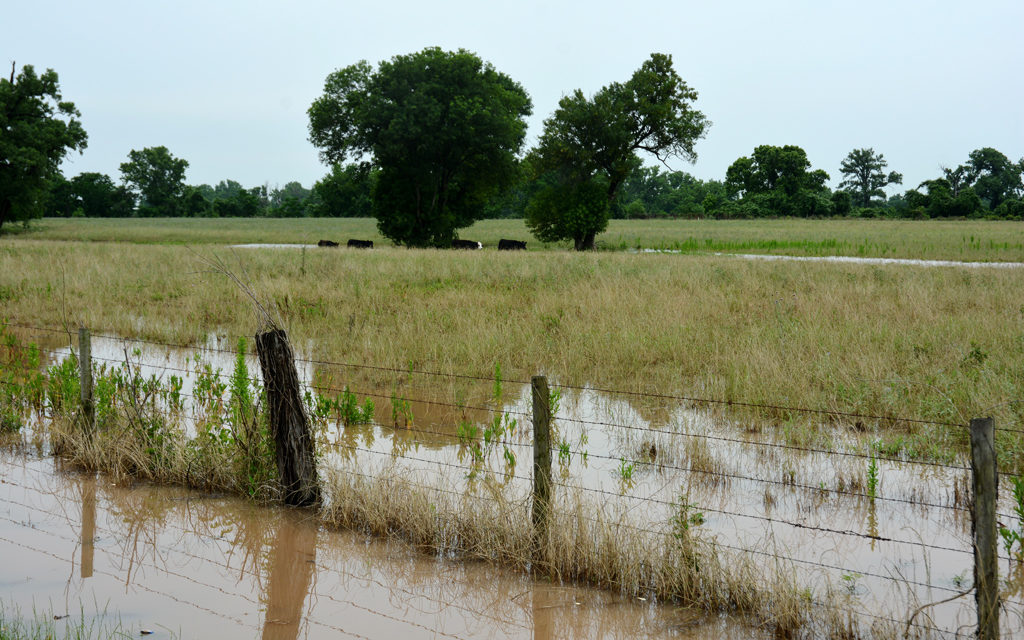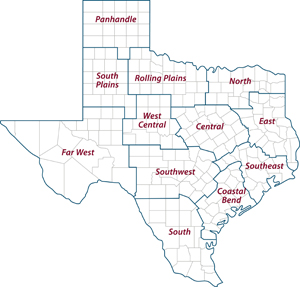Texas Crop and Weather Report
by Adam Russell
Recent rain events are delaying harvests of some warm-season crops and planting of cool-season crops, including winter forages for cattle producers, according to Texas A&M AgriLife Extension Service experts.
Widespread rains across Texas have brought much-needed moisture to drought-stricken areas of the state, but too much moisture is causing problems for producers trying to harvest and/or plant crops.
Dr. Clark Neely, AgriLife Extension state grains specialist, College Station, said producers in the Blacklands region have had a rough time getting small grains planted for fall forage. However, he said if producers had fields worked and prepped by August or early September, they likely were able to get planted.
But Neely said he’d received several calls about “sick-looking oats,” and his own research forage plots — normally planted by the end of September — were delayed as well.
“I’ve been waiting on fields to be worked in order to prepare the seedbed, but just as fields get almost dry enough to till, it rains again,” he said. “We are just now starting to hit what I would consider the early part of our typical planting season for grain wheat in the Blacklands. But I can pretty much guarantee no one has planted yet if they were waiting to plant for grain production only.”
If it were to stop raining right now, Neely said many fields would need 10-14 days to dry out amid cooler temperatures and cloudy weather with more rain in the forecast, which will push planting time back even further.
“With all that said, I wouldn’t consider the wheat to be planted late until we hit late November for most of the Blacklands and South Texas,” he said.
Neely said producers have until mid to late December to plant winter wheat for spring production in South Texas.
“On the plus side, growers who did get planted early will likely have abundant fall forage with all the moisture,” he said.
With regards to insurance, Neely said final plant dates are Oct. 31 for most of the western Panhandle and Southern High Plains; Nov. 30 for the eastern Panhandle and portions of the southern South High Plains; Dec. 15 for all of the Blacklands and most of the Rolling Plains; and Jan. 15 for most of South Texas.
Dr. Jourdan Bell, AgriLife Extension agronomist, Amarillo, said wet weather has also delayed wheat planting in the Panhandle. Due to excessive rains in some areas, some producers are having to replant wheat fields because fields flooded, causing seed to float.
Recent rains have significantly delayed harvests of cotton, corn and sorghum in addition to some late hay and silage crops, she said.
Bell estimated approximately 60 percent of corn and 30 percent of sorghum had been harvested.
“With extended delays, we could have stalk lodging resulting in harvest challenges,” she said.
Precipitation amounts varied across the Panhandle from 2 to 9 inches, and the region experienced its first hard freeze.
“There are concerns about the delayed cotton harvest due to extended periods of boll weathering,” Bell said. “We are seeing many fields with strung-out lint, but the degree varies across the region. In some areas, the weather may impact fiber quality, but we are not looking at a region-wide loss in lint yield from the mid-October precipitation events.”
Fortunately, a recent freeze was only for 16 hours or less, and conditions warmed up soon after, she said. Producers were very proactive in applying harvest aids, and fields are ready to harvest.
“Many farmers have been able to get back in fields over the weekend, but we are expecting rain to return mid-week, which will further delay harvest,” she said.
AgriLife Extension district reporters compiled the following summaries:
CENTRAL: Conditions were very wet from heavy rains, and temperatures were cooler. Stock tanks were full. Some supplemental feeding was provided to livestock on rangelands. Conditions were too wet to work fields. Hay fields needed cutting but conditions were too wet to cut and cure. There were some reports of cottonseed sprouting in bolls. Rain continued to delay wheat and oat planting. Moisture helped pastures but they were beginning to become saturated. All counties reported good moisture. Nearly all counties reported good crop, livestock, rangeland and pasture conditions.
ROLLING PLAINS: Fall weather set in earlier than expected. Conditions were cloudy, cold and wet. Temperatures dipped close to the freezing mark but did not register an official freeze. Winter wheat acres looked very good except for those under water. Cotton acres were in fair to good condition, but the recent moisture was detrimental to open bolls, which were beginning to string out. Forecasts called for more rain.
COASTAL BEND: Wet fields stopped nearly all field work, including cotton and rice harvests. Showers were helping pastures tremendously. No hay was being cut, and armyworms continued to be a problem. Some fall brush management applications were being made as weather allowed. Livestock markets were reporting big runs and good prices. Livestock were in good condition. Pecan harvest continued between rain events. There were some reports of pecans sprouting on the trees as a result of the excessive, continuous moisture.
EAST: The district got abundant rainfall, including Cherokee and Shelby counties, which reported 10-plus inches. Marion County reported ponds were almost full. Houston County reported most fields had standing water. Temperatures throughout the region dropped to lows in the 40s and did not get over 80 degrees in the daytime. Cool temperatures caused cool-season forages in Gregg, Marion, Shelby and Polk counties to make good growth. Sabine County reported a surplus of standing forage. Cherokee, Polk, Smith and Sabine county producers could not cut the much-needed hay due to wet conditions. Sabine County grazing conditions were excellent, while Cherokee County producers resorted to putting up silage. Pasture and rangeland conditions were excellent in Sabine County and poor in Marion County, with all other counties reporting fair to good conditions. Subsoil conditions were surplus in Angelina, Cherokee and Shelby counties and short in Marion County. All other counties reported adequate subsoil conditions. Topsoil conditions were short in Marion County and surplus in Angelina, Cherokee and Shelby counties. All other counties reported adequate topsoil conditions. Livestock were in good condition throughout the district. Cattle markets were low across the board in Houston County, while Shelby County prices held steady. Wild pig activity was reported in Gregg, Henderson and Wood counties.
SOUTH PLAINS: Subsoil and topsoil moisture levels were adequate to surplus. Recent rains significantly slowed down harvesting. Producers were waiting for drier conditions. The cotton crop was increasingly worse, as some counties received a light freeze. Farmers sprayed a lot of cotton and started stripping, which made it open and exposed it to moisture. Producers hoped the weather would cooperate, so they could access fields to begin cotton harvest and finish wheat planting. Ranchers in the area were very pleased with grass growth. Pasture, rangeland and winter wheat should improve with recent rain levels. Cattle continued to be in good condition.
PANHANDLE: Temperatures were slightly below average for most of the district. Most areas received their first freeze. Some areas reported heavy rains. Briscoe County reported highly saturated soils. Most counties were on hold for fieldwork due to recent moisture. Armstrong County reported poor cotton conditions. Weather was great for wheat. There was still corn in some fields, and quality was expected to decline. Cotton harvest was on hold with wet field conditions and rain in the forecast. Winter wheat was performing well with the recent rainfall, however there were still many acres to be planted. Hutchinson County experienced an extended freeze.
NORTH: Heavy rains of 2-5 inches fell across most of the district and created surplus moisture levels. Most counties reported producers were unable to harvest cotton and/or soybeans because of muddy conditions. Wheat planting was delayed as well. Armyworms were slowed by cooler weather. Livestock were in great condition since pastures recovered. Most spring calves were weaned.
FAR WEST: High temperatures were in the upper 80s with lows in the lower 30s. Rain amounts averaged 1-6 inches. Much of the district received heavy rains, leaving water standing in fields, and rivers and creeks swollen and dangerous conditions on roadways. Ranchers took precautions and checked on cattle due to conditions. Sun and higher temperatures should help forage growth and wintering livestock. Hay resources were limited and of concern going into winter months.
WEST CENTRAL: There was anywhere from 7-13 inches of rainfall reported throughout the district. Temperatures were colder than normal. Most tanks were full and lake level almost full. Some fields had standing water. Armyworm activity slowed down due to cold, wet weather. Producers were waiting for fields to dry enough to plant small grains. Livestock health decreased due to prolonged wet, cold weather.
SOUTHEAST: Wet conditions were preventing completion of the cotton harvest. Cold and wet conditions slowed armyworms down. The harvest of rice continued and should wrap up soon, and the ratoon crop harvest should start soon. Cooler weather helped knock down heavy mosquito numbers. Rangeland and pasture ratings varied from excellent to poor with fair ratings being most common. Soil moisture levels ranged from adequate to surplus with adequate being most common.
SOUTHWEST: Already saturated soil continued to received rain, with more precipitation predicted in the forecast. Producers were having a hard time harvesting and planting in wet conditions. Armyworms were still an issue. Overflowing rivers and creeks caused flooding, damaged roads and left standing water in fields. Livestock and wildlife were in good condition.
SOUTH: Northern parts of the district reported mild weather conditions and some scattered showers with adequate soil moisture levels. Western and eastern parts of the district reported wet conditions and adequate-to-surplus soil moisture levels. Jim Wells County reported up to 5 inches of rain. Peanut digging began but stopped due to rainfall. Wheat and oats planting resumed but was also halted due to rainfall. Pasture and rangeland conditions were good to excellent. Cooler temperatures slowed grass growth. Some fall armyworm activity continued, but cooler weather may slow down egg laying activity and development. Some producers battled wet conditions to ship calves, and body condition scores on cattle were good. Pecan orchards reported some losses with the rain and wind, but nothing major. Cabbage and spinach made good progress. Additional plantings of cabbage, onions, spinach and carrots were halted due to wet field conditions. Cotton ginning activity was on an around-the-clock schedule. Livestock continued to do well on lush green forage on native rangeland and pastures. Supplemental feeding of livestock was suspended. Some ranchers and deer breeders planted oats, wheat and winter rye. Hay harvest was delayed by rains. In Hidalgo County, citrus harvest was picking up momentum, and sugarcane harvest was underway where dry fields allowed. The county was still planting vegetables, and many field operations were hampered by wet conditions.





